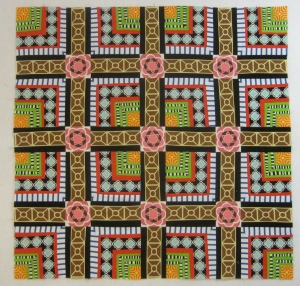For a long time I've wanted to try doing more with printed fabric. Nancy had us bring geometric prints to all three of the workshops I've done, but we never got very deep into using them. I have been following Maria Shell and really loving what she is doing with prints, specifically her Color Grid series,seen in this process shot she featured back in May.
 |
| Maria Shell - Color Grid Series |
So given a three hour window to mess around with, I pulled out the prints and started cutting strips and making "fabrics." I deliberately worked intuitively, without any particular plan in mind, but I did try to limit the color range and intensity. Once I had four or five strip sets made, I grabbed one and started slicing and dicing.
After I made the blue units, I threw them on the wall in a sort of grid pattern. Since there were eight of them, I had the concept in mind that they would evolve into eight blocks, and then I would make eight more out of other fabrics, and assemble 16 blocks in a checkerboard arrangement. That seemed sort of boring, though, so I started arranging them in more of an overall symmetrical layout, thinking I would have a greater number of different blocks and more of a reference to traditional quilt making block layouts that could create overall secondary patterns....
This is what the wall looked like this morning, after some additional fabrics and blocks were made.
I don't like it. Yet. I'm not sure what it's going to take to get it to something I like, but right now the whole overall arrangement thing is not working for me at all. Scattered, distracting, confusing, overly complicated. It's questionable whether I can get it anywhere that I will like it. I may have to go back to just having two blocks and repeating them, or otherwise simplifying. As an alternative, It might need to be more of a "chunk" arrangement. Where multiple blocks are grouped. I'm trying hard NOT to be too derivative of Maria's stuff, i.e. making a grid like hers. I find I get more focused on geometry and mental gymnastics, and not enough on the visual that is actually produced, or the figure/ground relationship. I wonder how they will look without all the white space... I created the fabric on the left out of solids, thinking it would be unifying between blocks. But - No. You can see a couple thin strips in the center. They are too big, in relation to the striped fabric.
Stay tuned.
In other news, I took apart the black and white "thing" and got rid of all the arbitrary angles. It's on the wall, and I played with adding some larger black areas. Now I'm distracted by the couple of lines that get too skinny. I thought they added interest or hierarchy or something, but now they are distracting. We'll see.
And then there's Jane. The temporary obsession with Jane has abated slightly. but I did enjoy the paper piecing, and it helped me practice precision. Not something I love, but something necessary.
I have sort of copied the blocks as drafted in the book, but also taken some liberties here and there. The last one I completed was the 16-square in the lower right. I did this by cutting squares, and it did not turn out sized correctly. I can see now why people use paper piecing even with simpler assemblages. More precision. Question is whether I'll redo it, or just make do?





Sharon- I stopped by to see what you were up to and was pleasantly surprised to see Marks' Garden on your site! Good for you to give prints a go. They do add one more thing to juggle when creating a composition. Some ideas I had when looking at your work--It is okay, in fact I think fabulous to be inspired by traditional quilt blocks. Right now the solids are reading as a lot of horizontal lines, so I wonder what would happen if you mixed that up? Bar quilts are always a good place to start. If you could get the bits to read as bars I think that might be really interesting. Lately, I've been looking at shapes in nature--in particular foliage. Maybe you could get the bits to read as shapes--archectiture might be a good place for you to start. Good luck. And I look forward to seeing what happens.
ReplyDeleteHi Maria - Thanks for stopping by my blog! I am glad you didn't mind my featuring your piece on my site - I have not seen anyone else using prints in such interesting ways.
DeleteI wish I'd seen your comment before I finished the piece last night. But maybe not - then I would have been inclined to fiddle with it even more. The finish is in my next blog post. I don't think it really reads as anything but a mish-mash... but hey, it's done. Time for the next attempt.